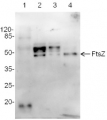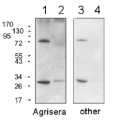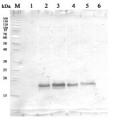1
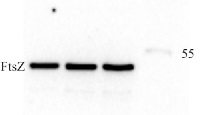
Anti-FtsZ | Procaryotic cell division GTPase
AS10 715 | Clonality: Polyclonal | Host: Rabbit | Reactivity: Candidatus Moranella endobia PCIT , Escherichia DH5a, Escherichia coli BW 25113, Shigella flexneri
- Product Info
-
Immunogen: KLH-conjugated synthetic peptide derived from known bacterial sequences of FtsZ including E.coli UniProt: P0A9A6 Host: Rabbit Clonality: Polyclonal Purity: Serum Format: Lyophilized Quantity: 50 µl Reconstitution: For reconstitution add 50 µl of sterile water Storage: Store lyophilized/reconstituted at -20°C; once reconstituted make aliquots to avoid repeated freeze-thaw cycles. Please remember to spin the tubes briefly prior to opening them to avoid any losses that might occur from material adhering to the cap or sides of the tube. Tested applications: Immunofluorescence (IF), Western blot (WB) Recommended dilution: 1 : 100-1 : 200 (IF), 1 : 1000 (WB) Expected | apparent MW: 40 | 42 kDa
- Reactivity
-
Confirmed reactivity: Candidatus Moranella endobia PCIT , Escherichia DH5a, Escherichia coli BW 25113, Shigella flexneri Predicted reactivity: Candidatus sp., Citrobacter sp. 30_2, Dickeya sp., <e
Species of your interest not listed? Contact usm>Enterobacter sp., Klebsiella pneumoniae subsp. pneumoniae MGH, Salmonella sp., Shigella sonnei Ss046, Vibrio sp., Yersinia pestis D182038, Xanthomonas oryzaeNot reactive in: Alysiella filiformis, B. subtilis, Haloferax mediterranei (Listera sp., Neisseria meningitidis, Pseudomonas aeruginosa, Staphylococcus aureus (strain MRSA252), cyanobacteria
- Application Examples
-
Application example 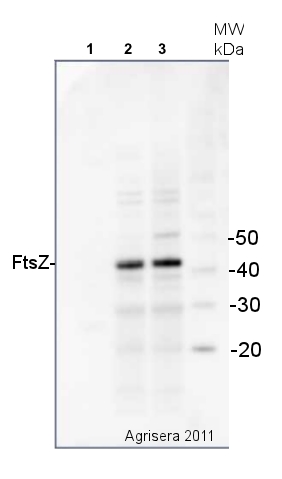
5 µg of total protein from Synechocystis sp. (1), E.coli DH5a (2), E. coli (3), extracted with Agrisera PEB extraction buffer were separated on 4-12% SDS-PAGE and blotted 1h to PVDF. Blots were blocked with Advance blocking reagent for 1h at room temperature (RT) with agitation. Blot was incubated in the primary antibody at a dilution of 1: 10 000 for 1h at RT with agitation. The antibody solution was decanted and the blot was rinsed briefly twice, then washed once for 15 min and 3 times for 5 min in TBS-T at RT with agitation. Blot was incubated in secondary antibody (anti-rabbit IgG horse radish peroxidase conjugated, from Agrisera, AS09 602) diluted to 1:25 000 in for 1h at RT with agitation. The blot was washed as above and developed for 5 min with ECL according to the manufacturers instructions. Exposure time was 120 seconds.
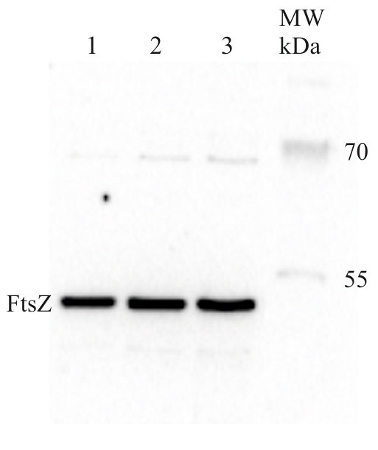
Total protein extract from E. coli CFT073: 8µg (1), 12µg (2), 16µg (3). Proteins were separated on 10% SDS-PAGE and blotted to PVDF. Blocked with 5 % non-fat milk in TBS-T for 1 hour. Blot was incubated in the primary antibody at a dilution of 1 :10 000 for 1 h at RT with agitation. Secondary antibody (anti-rabbit IgG, HRP conjugated, Agrisera, AS09 602) were diluted to 1 : 50 000 and blot was incubated for 1h at RT with agitation. Immunodetection was performed using chemiluminescent detection method for 3 min. Scan was made after 30 sec.
Courtesy of Dr. Marta Kicia, Wroclaw Medical University, Poland
- Background
-
Background: FtsZ (cell division GTPase) is a well characterized protein of the bacterial cell division apparatus. This protein accumulates early in dividing cells, and has a crucial role during septum formation in most bacteria. It has also been accepted as the bacterial cytoskeletal counterpart to eukaryotic microtubules. Synonymes: sifB, SulB.
- Product Citations
-
Selected references: Pokhrel et al. (2025). Uropathogenic Escherichia coli proliferate as a coccoid morphotype inside human host cells.PLoS Biol. 2025 Sep 3;23(9):e3003366. doi: 10.1371/journal.pbio.3003366.
Chakraborty et al. (2024). Dynamics of interdomain rotation facilitates FtsZ filament assembly. JBC, 7 May 2024, 107336.
Westlund et al. (2023). Application of nanotags and nanobodies for live cell single-molecule imaging of the Z-ring in Escherichia coli. Curr Genet. 2023 Jun;69(2-3):153-163. doi: 10.1007/s00294-023-01266-2. Epub 2023 Apr 6.
Zhao, Zhao & Nie (2022)Nanocarriers based on bacterial membrane materials for cancer vaccine delivery. Nat Protoc. 2022 Oct;17(10):2240-2274. doi: 10.1038/s41596-022-00713-7. Epub 2022 Jul 25. PMID: 35879454.
Vedyaykin et al. (2020). SulA is able to block cell division in Escherichia coli by a mechanism different from sequestration. Biochem Biophys Res Commun . DOI: 10.1016/j.bbrc.2020.03.012
Ranjit et al. (2020). Chlamydial MreB Directs Cell Division and Peptidoglycan Synthesis in Escherichia coli in the Absence of FtsZ Activity. mBio. 2020 Feb 18;11(1). pii: e03222-19. doi: 10.1128/mBio.03222-19. (Immunofluorescence)
Sekar et al. (2018). Synthesis and degradation of FtsZ quantitatively predict the first cell division in starved bacteria. Mol Syst Biol. 2018 Nov 5;14(11):e8623. doi: 10.15252/msb.20188623.
Mückl et al. (2018). Filamentation and restoration of normal growth in Escherichia coli using a combined CRISPRi sgRNA/antisense RNA approach. PLoS One. 2018 Sep 11;13(9):e0198058. doi: 10.1371/journal.pone.0198058. eCollection 2018.
Pende et al. (2014). Size-independent symmetric division in extraordinarily long cells. Nat Commun. 2014 Sep 15;5:4803. doi: 10.1038/ncomms5803.
Söderström et al. (2014). Disassembly of the divisome in Escherichia coli: Evidence that FtsZ dissociates before compartmentalisation. Mol Microbiol. 2014 Feb 7. doi: 10.1111/mmi.12534. (western blot and immunofluorescence) - Protocols
-
Agrisera Western Blot protocol and video tutorials
Protocols to work with plant and algal protein extracts - Reviews:
-
This product doesn't have any reviews.

